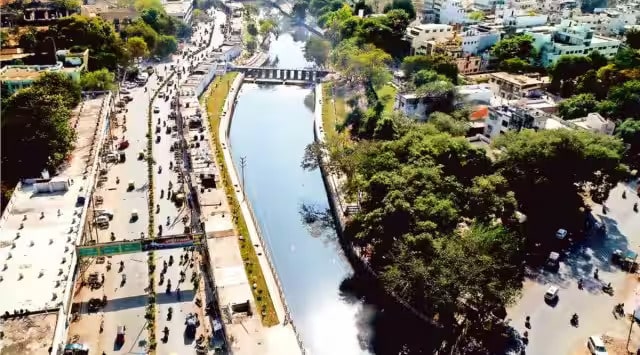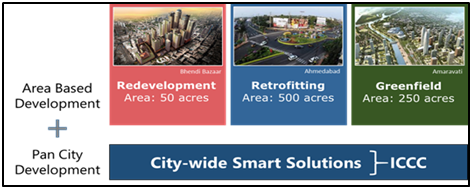What’s in Today’s Article?
- Why in News?
- About Smart Cities Mission
- Need for Smart Mission
- Core Infrastructure Elements of Smart Cities Mission
- Coverage of Smart Cities Mission
- Strategy of Smart Cities Mission
- Administrative Structure of Smart Cities Mission
- Financing of Smart Cities Mission
- Progress Made by Smart Cities Mission
- News Summary
Why in News?
- The Union Housing and Urban Affairs Ministry named Indore the best city and Madhya Pradesh the best state in the Smart Cities Mission in its India Smart Cities Awards 2022.
About Smart Cities Mission:
- Smart Cities Mission was launched by the Union government in June, 2015.
- The main objective of the Mission is to promote cities that provide core infrastructure, clean and sustainable environment and give a decent quality of life to their citizens through the application of ‘smart solutions’.
- The Mission aims to drive economic growth and improve quality of life through comprehensive work on social, economic, physical and institutional pillars of the city.
- The focus is on sustainable and inclusive development by creation of replicable models which act as lighthouses to other aspiring cities.
Need for Such Mission:
- Cities accommodate ~31% of India’s current population and contribute 63% to the GDP (Census 2011).
- By 2030, urban areas are expected to accommodate 40% of India’s population and contribute 75% to the GDP.
- Population growth in cities leads to infrastructure management and service delivery challenges.
- The Smart Cities Mission in India is an initiative that aims to efficiently and effectively tackle these challenges.
Core Infrastructure Elements of Smart Cities Mission:
- The core infrastructure elements in a Smart City are as follows:
- Adequate water supply
- Assured electricity supply
- Sanitation including solid waste management
- Efficient urban mobility and public transport
- Affordable housing, especially for the poor
- Robust IT connectivity and digitalization
- Good governance, especially e-governance and citizen participation
- Sustainable environment
- Safety and security of citizens, particularly women, children and the elderly
- Health and education
- The focus is on sustainable and inclusive development and the idea is to look at compact areas, create a replicable model to serve as a beacon to other aspiring cities.
Coverage of Smart Cities Mission:
- The mission will cover 100 cities that have been distributed among the States /Union Territories (UT) on the basis of an equitable criteria.
- The formula gives equal weightage (50:50) to urban population of the State/UT and the number of statutory towns (a town with a municipality, corporation, cantonment board or notified town area committee) in the State/UT.
- Based on this formula, each State/UT will, therefore, have a certain number of potential Smart Cities, with each State/UT having at least one.
Strategy of Smart Cities Mission:
- Components of area-based development in the 100 Smart Cities Mission in India comprise city improvement (retrofitting), city renewal (redevelopment) and city extension (greenfield development), along with a pan-city initiative.
- Area-based development that will transform existing areas, including slums, into better planned residential areas by retrofitting and redevelopment, thereby improving habitability of the whole city.
- Greenfield projects that will develop new areas in the city to accommodate the expanding population in urban areas.
- Pan-city development envisaging the application of select smart solutions to the existing city-wide infrastructure.
Administrative Structure of Smart Cities Mission:
- Guidelines on Smart City provide monitoring at three levels – national, state and city.
- National: An Apex Committee, headed by the Secretary of the Ministry of Urban Development and comprising representatives from related ministries and organisations, has the mandate to approve proposals, monitor progress and release funds.
- State: A High Powered Steering Committee (HPSC) to be headed by the Chief Secretary of the State, which would steer the Smart City Mission as a whole.
- City: A Smart City Advisory Forum in all Smart Cities, comprising the District Collector, Chief Executive Officer of Special Purpose Vehicle (an SPV is created for implementation at the city level.
- Its role is to release funds, and implement, monitor and evaluate the Smart City development projects), member of Parliament, member of Legislative Assembly, Mayor, local youth, technical experts and representatives of the area Resident Welfare Association to advise and enable collaboration.
Financing of Smart Cities Mission:
- The Smart Cities Mission in India is a Centrally Sponsored Scheme.
- It requires state governments and urban local bodies (ULBs) to contribute an equal amount for implementing projects under the Smart City Proposal (SCP).
Progress Made by Smart Cities Mission:
- As per data submitted by the Ministry of Urban Affairs & Housing in February 2023, more than two-thirds of the total 7,804 projects under the Smart Cities Mission (SCM) have been completed.
- According to SCM guidelines, the Union government is expected to provide financial support to the tune of Rs 48,000 crore to the 100 smart cities over a period of five years (2017-22) — almost Rs 100 crore per city per year on average.
- Compared to Rs 14,100 crore in FY 2022-23, the budgetary allocation for the Smart Cities Mission was hiked in the Union Budget for FY 2023-24 to Rs 16,000 crore.
- Of the total proposed projects under SCM, 6,041(76 per cent) projects worth Rs 1,10,635 crore have been completed and the remaining 1,894 projects worth Rs 60,095 crore will be finished by June 30, 2024.
- With about 768 projects, Karnataka topped the list of states with the most completed projects, followed by Madhya Pradesh (577), Uttar Pradesh (553), and Tamil Nadu (531).
- Raipur (235) in Chhattisgarh, Indore (220) in Madhya Pradesh, Tumakuru (199) in Karnataka, and Varanasi (104) in Uttar Pradesh were identified as the cities with the highest number of completed projects in their states.
News Summary:
- The Union Housing and Urban Affairs Ministry named Indore the best city and Madhya Pradesh the best state in the Smart Cities Mission in its India Smart Cities Awards 2022.
- Surat and Agra were named second and third best among cities and Tamil Nadu second in states, with the third prize being shared by Rajasthan and Uttar Pradesh.
- The cities were selected based on their ranking in terms of progress of projects, project outcomes and presentations submitted for the awards.
Q1) What is Urban Mobility?
Urban mobility is all of the movements of both people and goods that occur in a city via public or private transportation.
Q2) How does PPP model in infrastructure development work?
A public-private partnership (PPP) is a funding model for public infrastructure projects and initiatives such as a new telecommunications system, public transportation system, airport or power plant.
Source: Indore named best city, MP best state in Smart Cities Mission
Last updated on January, 2026
→ Check out the latest UPSC Syllabus 2026 here.
→ Join Vajiram & Ravi’s Interview Guidance Programme for expert help to crack your final UPSC stage.
→ UPSC Mains Result 2025 is now out.
→ UPSC Notification 2026 is scheduled to be released on January 14, 2026.
→ UPSC Calendar 2026 has been released.
→ UPSC Prelims 2026 will be conducted on 24th May, 2026 & UPSC Mains 2026 will be conducted on 21st August 2026.
→ The UPSC Selection Process is of 3 stages-Prelims, Mains and Interview.
→ Prepare effectively with Vajiram & Ravi’s UPSC Prelims Test Series 2026 featuring full-length mock tests, detailed solutions, and performance analysis.
→ Enroll in Vajiram & Ravi’s UPSC Mains Test Series 2026 for structured answer writing practice, expert evaluation, and exam-oriented feedback.
→ Join Vajiram & Ravi’s Best UPSC Mentorship Program for personalized guidance, strategy planning, and one-to-one support from experienced mentors.
→ UPSC Result 2024 is released with latest UPSC Marksheet 2024. Check Now!
→ UPSC Toppers List 2024 is released now. Shakti Dubey is UPSC AIR 1 2024 Topper.
→ Also check Best UPSC Coaching in India


















